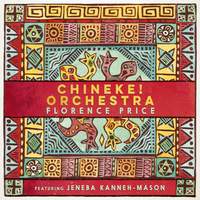Recording of the Week,
A new album of orchestral works by Florence Price from Jeneba Kanneh-Mason and Chineke!

Today’s Recording of the Week sees Jeneba Kanneh-Mason and Chineke! present a double-bill of major works by Florence Price, the seventieth anniversary of whose death fell at the beginning of the month. Her Piano Concerto in One Movement, premiered by Price herself (a formidable concert pianist) in 1934 and reconstructed by Trevor Weston after the loss of the original manuscript, is paired with her Symphony No.1 in E minor – the first symphony by a Black woman to be performed by a major American orchestra, and in some senses her breakthrough work, having scooped first prize in the 1932 Rodman Wanamaker Competition. Leslie Suganandarajah and Roderick Cox share the conducting honours, with Suganandarajah taking the podium for the concerto.
From the very beginning there’s a sense of showmanship – a brief, simple wind introduction outlines a distinctly Dvořák-ish motif that will do much of the heavy lifting in the first movement, followed by a striking solo cadenza. Suganandarajah creates a sense of nervous energy that Kanneh-Mason picks up on, propelling things inexorably forwards until the tension is released into a glorious, sweeping tutti for strings and piano, decorated with fragments of woodwind countermelodies.
A slow movement that defies conventional expectations

Price scholar Dr Samantha Ege refers in the sleeve notes to Price having a sense of humour in her music, and this comes through in the way the slow movement plays with the listener’s expectations. Piano and oboe (a stellar Myfanwy Price) luxuriate in an extended introductory duet – and given the chamber-music-abundant upbringing of the Kanneh-Masons, it’s no surprise that Jeneba is flawless in that hybrid role of half soloist, half accompanist. But just when it seems that the full orchestra’s entry is setting us up for a luscious Romantic cantabile, the music does a deft harmonic sidestep and begins instead to cool off into something more limpid.

Both the main works on this album are “top-heavy” in terms of the lengths of their movements; the concerto closes with a three-and-a-half minute dance that functions almost as a coda or curtain-call, and this is even more pronounced in the symphony. This is probably Price’s best-known work, popular both at the time and increasingly again today, and it’s easy to see why. There’s a direct lyricism which again calls to mind Dvořák – in particular his New World symphony, with which comparisons have often been made. Where it differs most, though, is in its more expansive sense of scale. At times it’s positively Brucknerian; that mature sense of confidently and unhurriedly sticking with something, be it a slow-burning buildup or some other musical mood, for exactly as long as it needs. Cox and the Chineke! wind principals in particular really respond to this; there’s an extensive passage of interwoven wind fragments where everyone has ample space and time to deliver each little statement as though it were a miniature solo.
The slow movement unfolds as a noble, quietly uplifting fifteen-minute meditation, in which Price’s deep relationship with church musicmaking could hardly be plainer; Cox and his lyrical wind principals are on magnificent form, and the selection of African drums with which Price expands the percussion section lend a gentle but welcome sense of optimistic forward motion.
Ending with a smile

In the wake of these two lengthy movements, a listener unfamiliar with the symphony might regard the final two, lasting four and five minutes respectively, with some surprise. But of course, it’s not as though Price made these movements short and sweet by mistake! It seems to be among her hallmarks, at least up to a point – the first movement of her Violin Concerto No.1, recently recorded by Randall Goosby), likewise takes up over half the piece’s length and its finale is again the shortest. The use of short, lively movements to conclude such pieces certainly seems unorthodox – even subversive. I suspect Dr Ege might again attribute this to Price’s sense of humour, and I wouldn’t disagree, but I wonder if there’s also an eye on pleasing the audience and making sure they go home humming something jolly!

For me, it wasn’t actually the final movement that most stuck with me, but rather the third, based on the Juba Dance whose syncopated rhythms must surely have found their way into the early roots of ragtime as well as inspiring Price a little later. A real toe-tapper that could easily work as an encore by itself – and if there’s one impression above all that I’ve gained of Florence Price as a composer, it’s that she sees absolutely no contradiction between that and the epic landscapes of the first two movements.
This symphony is increasingly becoming Price’s calling-card, and several recordings have come out in recent years; the concerto, though, deserves to be heard every bit as widely, and this sensitive new account of it will surely help further establish its place in the repertoire.
Jeneba Kanneh-Mason (piano), Chineke!, Leslie Suganandarajah, Roderick Cox
Available Formats: CD, MP3, FLAC, Hi-Res FLAC



